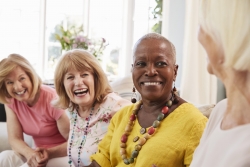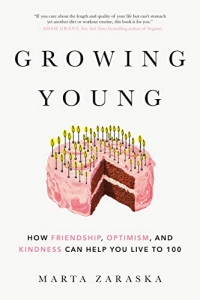When you think of healthy habits, what sorts of things come to mind? Eating a balanced diet with plenty of fruits and vegetables? Trying to get your 10,000 steps per day? Training for a 5K?

While these things certainly matter for health, a new book suggests that we’re overlooking an important part of wellness if we focus only on what we eat and how much we exercise. Instead, if we want to maximize our physical health, it may be just as important—if not more so—to focus on our social relationships and to treat others with kindness.
That’s the argument science writer Marta Zaraska makes in Growing Young: How Friendship, Optimism, and Kindness Can Help You Live to 100. Zaraska was always concerned with optimizing her family’s wellness, but new research made her start to question her approach. While reviewing studies, Zaraska noticed that, again and again, research pointed to our relationships as a central factor in health. If we want to live longer, healthier lives, we should prioritize staying connected, kind, and involved in our community.
How our social lives impact our health
Some of the most striking findings in Zaraska’s book focus on relationships and longevity. For example, one meta-analysis found that people with healthy and supportive relationships live longer, and that these effects are surprisingly strong. Over the course of studies averaging seven years long, research participants with larger social networks were about 45 percent less likely to die.
While some of this may seem surprising, it’s backed up by research: “There is absolutely nothing New Age-y here,” Zaraska says.
As she explains in her book, our mental state directly impacts biological processes in our body. When we experience stress, our bodies undergo a series of changes—output of cortisol (sometimes known as the “stress hormone”) increases and our cardiovascular system activates its “fight or flight” response.
Under stress, changes even occur to the immune system: Inflammation (which helps us fight off bacteria) increases, while our ability to fight off viruses decreases. Zaraska explains that there’s an evolutionary reason for these stress responses: They’re advantageous for dealing with the kind of acute threats that humans faced in our evolutionary past (such as running from a predator). But they’re not so well-suited to our current stressors, which tend to be less intense but chronic (such as worries about an ongoing work project).
One of the main stressors modern humans face—with corresponding effects on our biological systems—is loneliness. Loneliness has been found to increase cortisol and inflammation—both of which hurt our health over the long term. In one study Zaraska cites, research participants were voluntarily infected with a cold virus and then had their symptoms monitored by researchers. The result? Those who were socially isolated in life were 45 percent more likely to become ill.
While stress and loneliness can cause negative changes to our biological systems, taking time to connect with others can help activate more beneficial processes—such as the release of oxytocin. Oxytocin has been found to lower cortisol, reduce pain, change the way our brain responds to potential stressors, and even promote the growth of new brain cells. As Zaraska explains, hugs increase oxytocin levels, and so does eye contact (in fact, according to one study, making eye contact with your dog can increase oxytocin).
One way people can boost social connections is through volunteering or engaging in acts of kindness. Zaraska points out that people who volunteer tend to live longer, comparable to the benefit people receive from eating plenty of fruits and vegetables. In one study, elderly people who volunteered were 44 percent less likely to die over the course of a five-year study. In other studies, volunteers show lower levels of C-reactive protein and interleukin-6, both measures of inflammation. Research even suggests that those who engage in kind acts can see changes in the way genes for their immune system are expressed.
Zaraska points out that there’s been an increase in loneliness over the past several decades—we’re more likely to live alone, and less likely to feel we have people we can talk to. Especially now, reaching out to form new connections with others has the potential to improve our well-being and longevity.
Building new habits
Zaraska suggests a take-home lesson from this research: Because our social relationships are so important for health, it’s important to invest time in thinking about how to improve them. Just as you might meal-plan to create healthy meals for the week, or train for a 5K, it’s equally important to spend quality time with friends and family and think about how to incorporate kindness into your routine (whether that’s through formal volunteering or more informal random acts of kindness).
While writing her book, Zaraska spent a week engaging in regular acts of kindness: bringing someone chocolates, opening doors for others, leaving five-star reviews for businesses she wanted to support, and picking up trash. This is something you can try, too—and, as she points out, it will probably be more enjoyable than many of the diets and exercise programs you’ve done before for your health.
Even while practicing social distancing due to the coronavirus pandemic, we can find creative ways to bolster our close relationships. Zaraska says that, when catching up with friends remotely, a phone call beats texting: More oxytocin is released from talking on the phone than receiving the same type of information over text. She also recommends spending time to connect with the people you live with. For those living with their spouse or partner, planning date nights at home can be a way to spend time together; Zaraska recommends trying something new, such as dancing around your house or playing a quiz game.
Another way to stay connected involves finding opportunities to help others, such as sending a gift to a friend or bringing groceries to a family member or elderly neighbor. In Zaraska’s town, for example, people have been decorating mailboxes and leaving kind messages on their trash cans in order to thank mail carriers and sanitation workers.
Looking beyond the individual
Zaraska also acknowledges that many of these factors that impact our health are perhaps best understood at the level of the community, rather than the individual. For example, research suggests that people who live in a friendly and trusting neighborhood (what researchers would call a neighborhood high in “social capital”) have a lower risk of diabetes and cardiovascular disease.
She suggests that public officials think about fostering social connections among neighbors (for example, by creating walkable neighborhoods with public gathering spaces), creating programs that provide outreach to seniors who are at risk for loneliness, and having classes in schools that teach empathy. This doesn’t just make people happier—it’s also a public health issue.
 Growing Young: How Friendship, Optimism, and Kindness Can Help You Live to 100 (Appetite by Random House, 2020, 294 pages)
Growing Young: How Friendship, Optimism, and Kindness Can Help You Live to 100 (Appetite by Random House, 2020, 294 pages) Another way broader social factors impact individual health is through income inequality. While your own income doesn’t matter as much for health as you might think, a country’s level of equality—or lack thereof—does have an impact on its citizens’ well-being. In one meta-analysis of eleven countries, people living in places of increased inequality had a higher risk of death. Zaraska suggests considering the effects of how you vote—and voting for politicians who will implement policies that increase equality.
Promoting health isn’t just about behaviors that help us as individuals: Zaraska’s book convincingly argues that living a long and healthy life also means focusing on others—both in our own everyday actions and in our policies as a society.
Researching this book even inspired Zaraska to place a stronger emphasis on relationships in her own life. “I invest more time into my marriage. I stop to chat with neighbors. I try to be kinder,” she writes. “The very same efforts that rejuvenate our bodies and help us live long also help us grow as people.”


